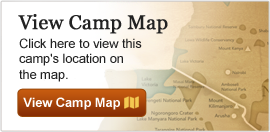Lewa Wilderness Lodge
distinctive Camp | Lewa / Laikipia, Kenya
| Read Reviews | Write a Review
Lewa Wilderness Lodge offers one of Kenya's oldest private safari experiences. For more than 40 years guests have visited this remarkable region to share an adventure like no other. Sitting in the shadow of Africa's second highest mountain, the lodge is at the heart of the Lewa Wildlife Conservancy, recently named a UNESCO World Heritage Site. Lewa is a private 65,000-acre sanctuary that is home to an enormous diversity of animals, including some of the most endangered species in Africa.

Our Expert Says
Located within the famous Lewa Conservancy, one of Kenya’s most successful private conservation efforts, Lewa Wilderness Trails Lodge is a perfect addition to any Kenya safari itinerary. The wildlife here is varied and plentiful and includes about 10 percent of Kenya's black rhino population and the single largest population of Grevy's zebra in the world. The property’s thatched bungalows and cozy common areas provide a comfortable stay, and the beautiful gardens on the grounds add to the enjoyment.
– Greg Courter

The Lodge
Location: Lewa Wildlife Conservancy, Kenya
Number of Cottages: 9
Wilderness Trails Lodge was once the homestead of the Craig family, owners of the original ranch that has become Lewa Wildlife Conservancy. The Craig's have welcomed travelers here for more than 40 years. Today, nine cottages, all with en suite facilities, log fireplaces and private verandas, accommodate a maximum of 18 guests. Options include family cottages in the garden or private chalets on the hill overlooking the former frontier district. Each of the rooms is unique, having changed in style over several successive generations of Craig family management. Guests are welcome to relax in the sitting area, the swimming pool or on the tennis courts. Shared meals are enjoyed around a banquet table in the open-air dining room, with an on-site farm producing many of the fresh ingredients. The lodge’s main areas overlook a wooded valley where a river flows year-round. Some of the best wildlife sightings happen right here, as lion, leopard and elephant often frequent this water source.

Facilities & Amenities
- En suite bathroom with tub and shower
- Fireplace
- Mini bar
- 220v charging outlets in room
- Central pool
- Tennis court
- Massage treatments (extra cost)
- Wi-Fi available
- Laundry included
- Local drinks included (house alcoholic and non-alcoholic drinks)

Wildlife Viewing & Activities
Lewa Conservancy offers a firsthand experience of groundbreaking wildlife conservation work. A pacesetter for bringing back endangered species, this private refuge has become the leading role model for sustainable conservation in East Africa. It has played an instrumental role in returning black and white rhinoceros from the brink of extinction and is also a sanctuary for Grevy's zebra and sitatunga, a rare aquatic antelope. Lewa’s mixed habitats include open grasslands and gentle hills, mature acacia forest and papyrus swamp, harboring a wide range of wildlife. The Big Five—lion, leopard, elephant, rhino and buffalo—thrive here alongside cheetah, wildebeest, hartebeest, giraffe, hippo, hyena, colobus monkey and wild dog. Lewa is home to more than 400 bird species, including Somali ostrich, kori bustard and lilac-breasted roller. On day and night wildlife drives, bush walks, horseback and camel rides against the backdrop of snowcapped Mt. Kenya, and scenic flights by open-cockpit biplane (extra cost), learn about Lewa’s mission to act as a catalyst for conservation across Africa.
The conservancies of the Laikipia District have varying concentrations and species of wildlife, and the below chart helps to illustrate major wildlife sightings often experienced in the area. Lewa Wildlife Conservancy is a rhino sanctuary, and this and other reserves in Laikipia feature unique subspecies, such as reticulated giraffe, Grevy’s zebra, Somali ostrich, gerenuk, and Jackson’s hartebeest and a number of other mammals, birds and reptiles. Exact sightings will depend on seasonality and wildlife movements.
| Country | Park/Reserve |
Black Rhino
|
Buffalo
|
Cheetah
|
Eland
|
Elephant
|
Gemsbok / Oryx
|
Giraffe
|
Greater Kudu
|
Hyena
|
Leopard
|
Lion
|
White Rhino
|
Wild Dog
|
Zebra
|
|
|---|---|---|---|---|---|---|---|---|---|---|---|---|---|---|---|---|
| Kenya | Lewa / Laikipia |
| Usually viewed | Frequently viewed | Occasionally viewed | Sporadically viewed | Rarely to never viewed |
Climate
| Month | Max | Min | Rainfall |
|---|---|---|---|
| January | 75° F | 55° F | 1.89 in |
| 23° C | 12° C | 48 mm | |
| February | 79° F | 54° F | 1.93 in |
| 26° C | 12° C | 49 mm | |
| March | 79° F | 55° F | 4.09 in |
| 26° C | 12° C | 104 mm | |
| April | 77° F | 59° F | 10.67 in |
| 25° C | 15° C | 271 mm | |
| May | 75° F | 59° F | 6.18 in |
| 23° C | 15° C | 157 mm | |
| June | 75° F | 57° F | 1.02 in |
| 23° C | 13° C | 26 mm | |
| July | 72° F | 55° F | 1.06 in |
| 22° C | 12° C | 27 mm | |
| August | 72° F | 54° F | 1.26 in |
| 22° C | 12° C | 32 mm | |
| September | 77° F | 55° F | 1.18 in |
| 25° C | 12° C | 30 mm | |
| October | 79° F | 57° F | 8.7 in |
| 26° C | 13° C | 221 mm | |
| November | 73° F | 57° F | 10.59 in |
| 22° C | 13° C | 269 mm | |
| December | 73° F | 54° F | 4.21 in |
| 22° C | 12° C | 107 mm |

Conservation
With the precipitous decline of black rhinos across Africa in the 1970s, government wildlife agencies and conservation organizations increasingly turned to private landowners, non-profit organizations and indigenous communities to protect the few remaining animals. In Kenya, the number of black rhinos dropped from an estimated 20,000 to fewer than 300 animals, and the only way to prevent their complete extinction was to create high security sanctuaries. In 1983, David and Delia Craig set aside 5,000 acres of their ranch as a rhino sanctuary, and the rest is history, as they recruited extensive support to help track, capture and relocate every remaining wild rhino in northern Kenya for breeding and protection. The program was so successful that eventually the entire ranch, encompassing 65,000 acres of diverse wildlife habitat, became the non-profit Lewa Wildlife Conservancy in 1995.Today, Kenya’s premier wildlife refuge and rehabilitation center employs more than 300 people and works with local communities in innovative approaches to conservation.
Reviews for Lewa Wilderness Lodge
Review Lewa Wilderness Lodge

















